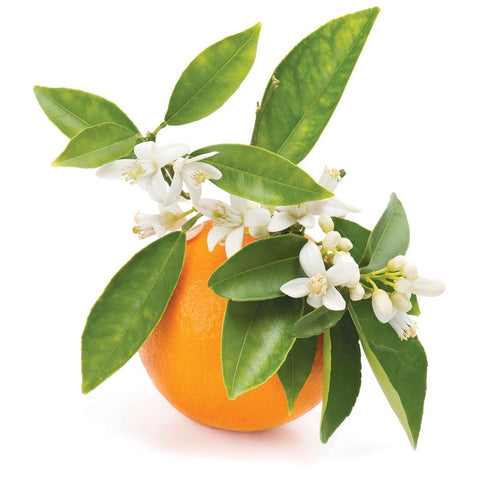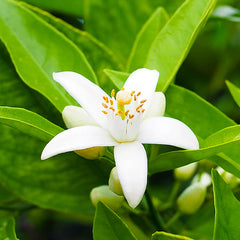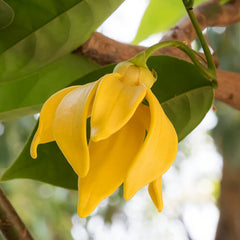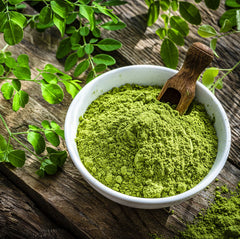What Does Petitgrain Smell Like?
Click For Affordable Inspired Perfume Alternatives

Dive into the aromatic realm of petitgrain, a fragrance that captures the essence of citrus groves and whispers of sophistication. Derived from the leaves and twigs of the bitter orange tree, petitgrain is a hidden gem in the world of perfumery. In this olfactory exploration, we'll uncover the answer to the question: What does petitgrain smell like?
What Does Petitgrain Smell Like?
Enter the aromatic realm of petitgrain, where the fragrance is a citrus symphony with a touch of green elegance. Join me on a journey to unravel the captivating aroma that defines the essence of petitgrain.
Citrus Elegance: A Subtle Citrus Dance
Petitgrain introduces itself with a subtle yet elegant citrus dance. The fragrance is akin to the essence of fresh oranges, but with a twist of sophistication. Petitgrain's aroma is a testament to the refined side of citrus, a delicate ballet that charms the senses with its understated grace.
Green Vibrancy: A Hint of Fresh Leaves
Interwoven with the citrus elegance is a subtle green vibrancy. It's as if the fragrance captures the essence of fresh citrus leaves, adding a touch of natural sophistication. Petitgrain's aroma is a sensory experience that not only invigorates but also evokes a sense of being surrounded by lush greenery.
Bitter Sweetness: A Nuanced Symphony
While predominantly citrusy, there's a nuanced undertone of bitter sweetness. This bitter sweetness adds complexity to the fragrance, creating a well-balanced olfactory composition that is both refreshing and intriguing. Petitgrain's aroma is a symphony where bitter and sweet notes play in harmony.
Clean Crispness: A Breath of Fresh Air
Delve deeper into the scent, and you'll discover a clean crispness that pervades petitgrain's fragrance. The scent is invigorating, like a breath of fresh air after a summer rain, making it an ideal companion for moments of rejuvenation and clarity.
Petitgrain's Olfactory Ballet
Hence, petitgrain's fragrance is an olfactory ballet of citrus elegance, green vibrancy, bitter sweetness, and clean crispness. It stands as a testament to the nuanced and refined qualities of this citrus essence, offering a sensory experience that is both delicate and invigorating. Petitgrain, with its subtle and complex aroma, invites us to appreciate the natural sophistication found within its essence, a fragrant journey that unfolds with every delightful whiff.
Buy Petitgrain Fragrance Oil
Brand: Stone Candles - Petitgrain Fragrance Oil(Note: Blended with other notes for a well rounded fragrance)
Factors That Affect The Smell Of Petitgrain
Various factors can influence the aroma of petitgrain oil:
-
Plant Part Used: Petitgrain oil is obtained from the leaves and twigs of the bitter orange tree. The specific part of the plant used for extraction can influence the oil's fragrance.
-
Bitter Orange Varieties: The bitter orange tree has different varieties, and petitgrain oil can be sourced from different subspecies or cultivars. Variations in fragrance may occur based on the specific variety.
-
Geographical Origin: The region where the bitter orange trees are grown can impact the aromatic profile of petitgrain oil. Soil composition, climate, and altitude all play a role in influencing the chemical composition of the oil.
-
Harvesting Practices: The timing and method of harvesting the leaves and twigs can affect the scent of petitgrain. Proper harvesting practices, including selecting the right stage of growth, contribute to the oil's quality.
-
Extraction Method: The method used to extract petitgrain oil, such as steam distillation, affects its fragrance. Different extraction methods may yield variations in the aromatic compounds present in the oil.
-
Age of the Plant Material: The age of the leaves and twigs used for extraction can influence the oil's scent. Younger plant material might produce a fresher, more vibrant aroma compared to older material.
-
Storage Conditions: Like many essential oils, petitgrain oil is sensitive to light, heat, and air. Proper storage is essential to preserve its freshness and prevent oxidation, which can lead to changes in fragrance.
-
Blending: Petitgrain is often used as a base note in perfumery, and its aroma can be influenced by other essential oils it is blended with. The final scent of a perfume or product containing petitgrain depends on the overall formulation.
-
Quality of the Oil: The overall quality of petitgrain oil, including whether it is pure and free from contaminants or additives, can impact its fragrance.
-
Cultural Practices: Local cultivation and cultural practices in the regions where bitter orange trees are grown can contribute to the unique characteristics of petitgrain oil from that area.
As with any essential oil, the individual preferences of users can also play a significant role in how petitgrain's scent is perceived. The oil is valued for its versatility and is commonly used in perfumery, aromatherapy, and skincare products.
What To Look For When Buying Petitgrain Oil
If you're looking to purchase pure petitgrain essential oil, here are some tips:
-
Botanical Name:
- Check that the essential oil is labeled with its botanical name, which is Citrus aurantium var. amara for petitgrain. This ensures that you're getting oil specifically derived from the bitter orange tree.
-
Ingredients:
- Pure petitgrain essential oil should have only one ingredient listed on the bottle: "Citrus aurantium var. amara (Petitgrain) Oil" or something similar. Avoid oils that contain synthetic fragrances or other additives.
-
Color:
- Petitgrain essential oil is typically pale yellow to amber in color. It should not be completely clear, as the presence of some color indicates that it is a natural product. However, extremely dark or cloudy oils may be of lower quality.
-
Aroma:
- Petitgrain essential oil has a distinct citrusy, floral scent with woody undertones. It should not have an overly sharp or artificial smell. Test the aroma to ensure it aligns with the characteristic petitgrain fragrance.
-
Packaging:
- Essential oils are sensitive to light and air, which can degrade their quality. Choose petitgrain essential oil packaged in dark glass bottles to protect it from light exposure. A bottle with a dropper or reducer cap is also useful for controlled dispensing.
Where to Find Reputable Sources:
-
Specialty Health Food Stores:
- Health food stores that carry essential oils may have petitgrain oil in their selection. These stores often focus on natural and pure products.
-
Aromatherapy Shops:
- Specialty aromatherapy shops or stores that cater to those interested in essential oils and natural fragrances are good places to find high-quality petitgrain oil.
-
Online Retailers:
- Reputable online platforms, such as Amazon, may offer a variety of essential oils, including petitgrain. Read product descriptions, customer reviews, and ratings to gauge the quality and authenticity of the oil.
-
Certified Aromatherapy Brands:
- Some brands specialize in producing high-quality, pure essential oils for aromatherapy. Look for brands that emphasize transparency, purity, and adherence to quality standards.
-
Local Herbalist or Apothecary:
- Local herbalists or apothecaries may carry petitgrain essential oil or be able to recommend trusted sources. These professionals often prioritize the quality and authenticity of their products.
-
Word of Mouth:
- Seek recommendations from individuals who use or are knowledgeable about essential oils. Personal experiences and insights can guide you to reputable sources.
Always exercise caution when encountering essential oils with unusually low prices, as they may not be genuine or of high quality. Taking the time to research and choose a reputable source ensures that you get the full benefits of pure petitgrain essential oil for aromatherapy or other uses.
20 Questions and Answers about Petitgrain:
-
Is petitgrain a common note in perfumery?
- Yes, petitgrain is a popular choice in perfumery, often used for its fresh and uplifting citrus profile.
-
Can petitgrain be a dominant note in perfumes?
- Petitgrain is frequently used as both a top and middle note, contributing its citrusy brightness and herbal nuances to perfumes.
-
Does the scent of petitgrain differ between varieties of bitter orange trees?
- Yes, the specific variety of bitter orange tree can influence the nuances in petitgrain's fragrance.
-
Can petitgrain be blended with other citrus notes in perfumery?
- Absolutely, petitgrain harmonizes seamlessly with other citrus notes, creating a layered and dynamic olfactory experience.
-
Does petitgrain's scent have calming properties?
- Yes, petitgrain is often associated with calming and soothing effects, making it a popular choice in aromatherapy.
-
Is petitgrain fragrance suitable for all genders?
- Petitgrain's versatile and unisex fragrance makes it appealing across genders in the world of perfumery.
-
Can petitgrain be used as a single-note fragrance?
- While less common, some perfumers appreciate petitgrain as a standalone note, showcasing its unique citrus and herbal character.
-
Is petitgrain used in natural perfumery?
- Yes, petitgrain's natural and botanical profile aligns well with the principles of natural and organic perfumery.
-
Does the climate affect the scent of petitgrain?
- Petitgrain thrives in warm climates, and the intensity of its fragrance can be influenced by factors such as sunlight and temperature.
-
Can petitgrain be used in scented candles?
- Yes, the bright and refreshing scent of petitgrain can be infused into candles, creating an uplifting and aromatic atmosphere.
-
Are there cultural associations with the scent of petitgrain?
- Petitgrain is often linked to Mediterranean landscapes and is associated with the breezy, sun-drenched ambiance of these regions.
-
Can petitgrain be used in culinary perfumery?
- While not a common culinary ingredient, petitgrain's citrusy and herbal notes may add a unique touch to certain dishes.
-
Does petitgrain's scent change with the age of the leaves and twigs?
- The age of the leaves and twigs can influence the nuances in petitgrain's fragrance, with younger foliage often yielding a brighter scent.
-
Is petitgrain fragrance long-lasting in perfumes?
- While a top and middle note, petitgrain's fragrance can linger, especially when complemented by other enduring base notes in a perfume.
-
Can petitgrain be used in room sprays for its fragrance?
- Yes, petitgrain's fresh and uplifting scent makes it a popular choice for room sprays and air fresheners.
-
Does petitgrain's fragrance have invigorating properties?
- Petitgrain's bright and citrusy profile is often associated with invigorating and revitalizing effects on the senses.
-
Can petitgrain be blended with floral notes in perfumery?
- Yes, petitgrain's citrusy brightness complements floral notes, creating a well-balanced and sophisticated fragrance.
-
Are there any known allergies to the fragrance of petitgrain?
- Allergic reactions to petitgrain's fragrance are rare, but individuals with sensitivities to citrus may want to exercise caution.
-
Can petitgrain's scent be influenced by soil composition?
- The quality of the soil can impact the potency of petitgrain's fragrance, with well-drained and nutrient-rich soil enhancing its aromatic profile.
-
Is petitgrain used in mainstream or niche perfumery?
- Petitgrain finds its place in both mainstream and niche perfumery, appreciated for its timeless and sophisticated citrus fragrance.
In Conclusion:
Petitgrain, with its citrusy allure and herbal finesse, beckons us to savor the essence of citrus groves and sun-drenched landscapes. Its refreshing and refined fragrance, a testament to the versatility of citrus in perfumery, makes it a cherished ingredient. So, the next time you encounter the elegant scent of petitgrain, let it transport you to a place where the zest of citrus intertwines with the grace of nature, leaving a trail of timeless sophistication in its wake.
Buy Perfumes - Best Online Retailers
Click For Affordable Inspired Perfume Alternatives
Click For The Best Niche Perfumes & Decants
Pheromone Perfumes - Confidence, Attraction & Appeal - Click For More
Home Fragrances & Candle Warmers - Click To Scent Up Your Spaces Today!



